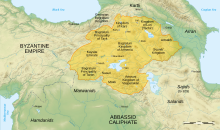Ashot III. Bagratuni
Ashot III. Bagratuni (also: Ashot the blind ; Armenian Աշոտ Կուրացյալ ; * around 690; † 762) was a prince from the Bagratuni family . He was prince of the Ostikhanat Arminiya from 726 and carried the title Ishkhan (ishxan) from 732 to 748 . He was the nephew of Sembat VI. Bagratuni .
By defeating one of the emirs who rose against Baghdad and attacked Armenia , he won the trust of the caliphate . His rise to power was also the rise of the Bagratid family.
In 732 caliph Hisham ibn ʿAbd al-Malik appointed him prince of Arminiya, but he had to oppose revolts by the sons of Sembat VI. enforce who claimed the goods of their father. In addition, the brothers David and Grigor Mamikonian ( Armenian Գրիգոր Բ Մամիկոնյան , Grigor B Mamikonjan) fought for supremacy in Armenia.
Grigor Mamikonian was actually made Prince of Arminiya in 745, but with the support of the Caliph, Ashot forced the brothers into exile in Yemen in 746 . However, they returned to Armenia as early as 748. Ashot had David Mamikonian imprisoned and executed. Grigor reciprocated by capturing Aschot and allowing him to be blinded . Soon after, in 750, the Umayyad caliphs were deposed and massacred by the Abbasids, and Aschot, who was too closely associated with the Umeyyads, was ousted. The title “Prince of Arminiya” was stripped from him and he was defenselessly exposed to the envy of the competing feudal houses of Armenia. At his best, his power was so great that in a short space of time he was able to raise an army of 90,000 men and send them into battle.
He had two sons: Sembat VII. Bagratuni (Սմբատ Է Բագրատունի) and Vasak Bagratuni (Վասակ Բագրատունի).
His successor was his cousin Sahak VII. Bagratuni (Սահակ Գ Բագրատունի), who appeared from 755 as a Nacharar .
Individual evidence
- ^ Christian Settipani: Continuité des élites à Byzance durant les siècles obscurs. Les princes caucasiens et l'Empire du VIe au IXe siècle. Paris, de Boccard, 2006: 335-7. ISBN 978-2-7018-0226-8
- ^ René Grousset: L'Empire du Levant: Histoire de la Question d'Orient. Paris, Payot, coll. " Bibliothèque historique " 1949, réimpr. 1979: 129. ISBN 2-228-12530-X
Web links
- Ashot III. of Armenia with Bernd Josef Jansen Genealogy
| personal data | |
|---|---|
| SURNAME | Ashot III. Bagratuni |
| ALTERNATIVE NAMES | Աշոտ Կուրացյալ (Armenian) |
| BRIEF DESCRIPTION | Prince of the Bagratuni family |
| DATE OF BIRTH | around 690 |
| DATE OF DEATH | 762 |
